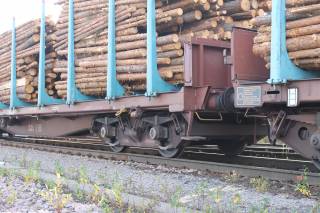- The effect of freight wagon bogie type on track loads
- Functional requirements of high-speed turnouts in Finland
- Monitoring the influence of heavy train loads on track
- Evaluating the functionality and effects of different track draining solutions in Finland
- Evaluating track load bearing capacity using data mining method
- EPSILON – Eurocode-based design system to guide the quality of infrastructure projects
- Robustness and structural safety of post-tensioned concrete bridge in case of tendon failure
The effect of freight wagon bogie type on track loads
 Track loads are very much dependent on the rolling stock operating on certain track section. Especially the speed of a vehicle, vehicle type, axle load, and the condition of a vehicle have a considerable effect on track loads. The aim of this research is to find out how different types of freight wagons operating on Finnish track load the track structure and cause wear on rails. Developing a procedure to estimate the loading characteristics of different freight wagons is also one goal. This can be done with the help of vehicle models and simulations.
Track loads are very much dependent on the rolling stock operating on certain track section. Especially the speed of a vehicle, vehicle type, axle load, and the condition of a vehicle have a considerable effect on track loads. The aim of this research is to find out how different types of freight wagons operating on Finnish track load the track structure and cause wear on rails. Developing a procedure to estimate the loading characteristics of different freight wagons is also one goal. This can be done with the help of vehicle models and simulations.
More information: Doctoral researcher Tiia Loponen
Functional requirements of high-speed turnouts in Finland
After the last project “Development in turnouts” it was clearly seen that the development of high-speed turnouts has to be continued towards more functional aspects. Finland already have 1:26- and 1:28 – turnouts which have been designed to increased speeds, but these structures are really long and expensive so also shorter turnout types for higher speeds are needed to build the whole high-speed rail sections. These higher speeds bring new demands to these shorter turnouts like more sophisticated point operation equipment (POE) and movable frogs. Movable frog will increase the complexity of the turnouts structure, but on the other hand, the dynamic impacts will decrease dramatically as the discontinuity point of crossing disappears. It is also well known that these kinds of high-speed turnouts are already in use in many countries, so experiences from those have to be gathered and utilized.
Besides these high-speed turnouts, also other concerns are arisen related to turnouts. Tight tolerances of especially inspection values i and g has led to situation where many new turnouts are failing to pass the inspection of delivery. The shape of the turnout crossing element can be minimally changed during delivery which already can cause the failing in the inspection. Maintenance crew also doesn’t have effective tools to properly estimate the wearing rate of turnouts switch area in 60E1 turnouts.
The main goal in this study is to:
- Define more disturbance-free turnouts for the high-speed track.
- Define completely new turnouts type (elastic 1:18-turnout with movable frog)
- Improve the structure of current 1:26- and 1:28- high-speed turnout structure to ensure the functionality and safety.
- Simulate how much turnouts inspection values can be changed without influencing the safety of turnouts. (54E1 and 60E1)
- Develop a new measuring tool for estimating the wear rate of switch area in 60E1-turnouts.
More information: Doctoral researcher Riku Varis

